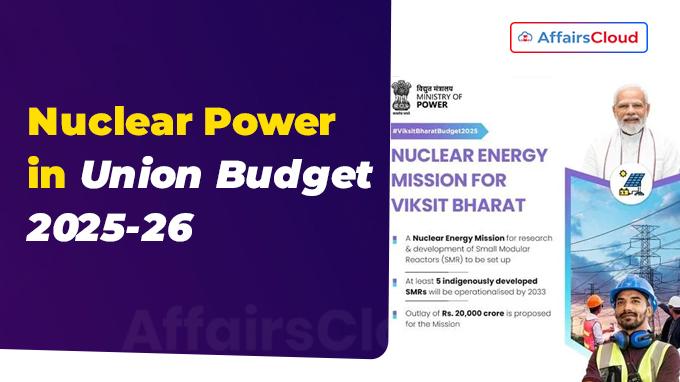 On February 1, 2025, Union Minister Nirmala Sitharaman, Ministry of Finance (MoF) presented her 8th Union Budget 2025-26, highlighting a focus on nuclear energy. Key focus is on developing indigenous nuclear technology, encouraging private sector participation, and making key investments in nuclear infrastructure.
On February 1, 2025, Union Minister Nirmala Sitharaman, Ministry of Finance (MoF) presented her 8th Union Budget 2025-26, highlighting a focus on nuclear energy. Key focus is on developing indigenous nuclear technology, encouraging private sector participation, and making key investments in nuclear infrastructure.
- India has set an ambitious target of 100 Gigawatt (GW) of nuclear power by 2047 as part of its long-term energy strategy.
- This goal, highlighted in the Union Budget 2025-26, aims to strengthen energy security, reduce dependence on fossil fuels, and support the vision of Viksit Bharat (Developed India).
Key Initiatives
Nuclear Energy Mission
The Nuclear Energy Mission for Viksit Bharat is a major initiative to promote research and innovation in nuclear power,
i.To support this, the government has allocated Rs 20,000 crore (USD 2.6 billion) to develop five indigenous Small Modular Reactors (SMRs) by 2033.
ii.The Government of India (GoI) plans to collaborate with the private sector to:
- Establish Bharat Small Reactors (BSRs)
- Support research and development (R&D) of Bharat Small Modular Reactors (BSMRs)
- Advance new technologies in the nuclear energy sector
Bharat Small Modular Reactors (SMRs):
SMRs are compact nuclear reactors that generate between 30 Megawatt-electric (MWe) and 300+ MWe of power.
- Bhabha Atomic Research Centre (BARC) based in Mumbai, Maharashtra develops indigenous SMRs to replace coal-based power plants and supporting clean energy goals.
Bharat Small Reactors (BSRs):
The government is also developing Bharat Small Reactors (BSRs), which are 220 MW Pressurized Heavy Water Reactors (PHWRs) with a proven safety record.
- Modified for land efficiency, ideal for steel, aluminum, and metal industries.
- Private sector participation: Companies provide land, water, and capital, while Nuclear Power Corporation of India Limited (NPCIL) based in Mumbai manages design and operation.
Key Points:
i.The Government of India plan is to expand nuclear capacity from 8,180 MW in 2024 to 22,480 MW by 2031-32 by:
- Constructing 10 new reactors (totaling 8,000 MW) in Gujarat, Rajasthan, Tamil Nadu (TN), Haryana, Karnataka, and Madhya Pradesh (MP).
- Starting pre-project work for 10 more reactors, which will be completed by 2031-32.
- Partnering with the United States of America (USA) to build a 6 x 1208 MW nuclear plant at Kovvada,Srikakulam district of Andhra Pradesh (AP).
ii.Supports India’s target of 500 GW non-fossil fuel energy by 2030, with 50% from renewables.
Iii.DAE (Department of Atomic Energy), under the Prime Minister’s direct charge, plans to develop advanced nuclear reactors, including high-temperature gas-cooled reactors for hydrogen production and molten salt reactors.
iv.Amendments to the Atomic Energy Act 1962 and the Civil Liability for Nuclear Damage Act 2010 will be proposed to enable private sector participation in nuclear power projects.
Key Advancements in India’s Nuclear Sector:
- RAPP-7 Criticality Achieved: Rajasthan Atomic Power Project Unit-7 (RAPP-7) achieved criticality (controlled nuclear reaction) on September 19, 2024.
- Kakrapar PHWRs Operational: Two 700 MWe PHWRs (KAPS-3 & 4) at Kakrapar, Gujarat, began commercial operations in FY 2023-24.
- India’s first Prototype Fast Breeder Reactor (PFBR) – 500 MWe made major progress in 2024, including primary sodium filling, purification, and sodium pump commissioning. Core loading started on March 4, 2024.
- India’s closed fuel cycle strategy, enhancing the efficiency and sustainability of its nuclear power program.
- India’s Largest Nuclear Plant: Kudankulam Nuclear Power Plant (KKNPP), Tamil Nadu, remains India’s largest nuclear facility, with each unit generating 1,000 MWe.
- First uranium mine in India: Discovered in Jaduguda Uranium Mines, Jharkhand.It was the first uranium mine in India.
- NPCIL-NTPC Joint Venture (ASHVINI): NPCIL and National Thermal Power Corporation Limited (NTPC) based in New Delhi (Delhi) formed a joint venture (JV) named ASHVINI to develop nuclear power plants under the Atomic Energy Act 1962 (amended in 2015).
- Key project is the 4×700 MWe PHWR at Mahi-Banswara, Rajasthan.
Click here for more details
About Ministry of Finance (MoF):
Union Minister– Nirmala Sitharaman (Constituency- Rajya Sabha- Karnataka)
Minister of State (MoS)– Pankaj Chaudhary (Constituency- Maharajganj, Uttar Pradesh, UP)



